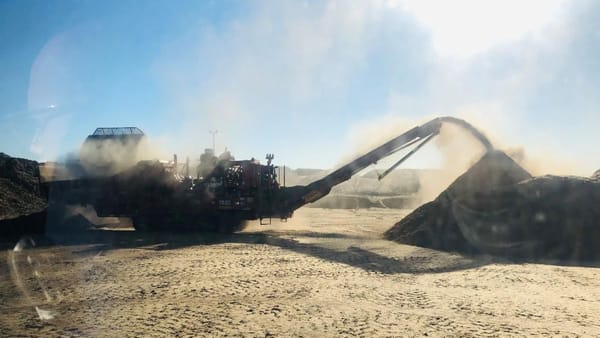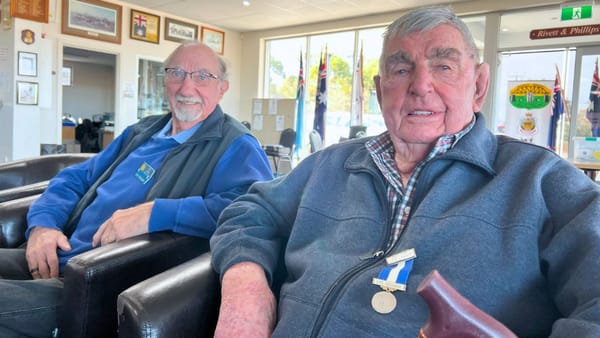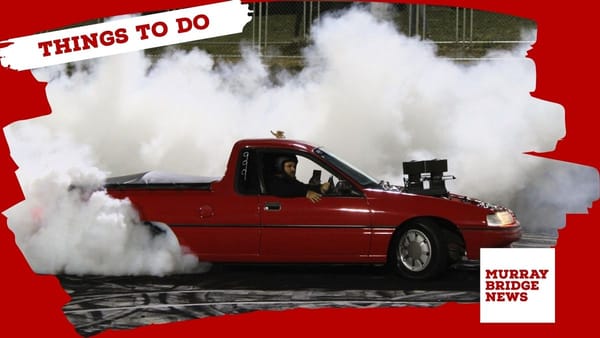River Murray's health is worsening, but Paiwalla volunteers are fighting the current
Take a tour of the Paiwalla Wetland and meet some of the folks at work there.

This story was originally published behind Murray Bridge News’ paywall. Paywalled stories are unlocked four weeks after publication. Can’t wait that long? Subscribe here.

The River Murray’s health is average and getting worse in some respects, according to a landmark report – but there are locals working to reverse that trend.
Fifteen kilometres upstream of Murray Bridge, volunteers sit around a table, sipping cuppas beside a sparkling stretch of water ringed by reeds and towering gum trees.
When their cups run dry, they’ll set off to do odd jobs: poisoning pest trees, pulling out weeds, fixing a quad bike used on the property.
The property in question is the Paiwalla Wetland: a privately owned habitat for native birds, animals and trees.
Waterbirds call out to each other in various languages, monarch butterflies flit about and the reeds rustle in the breeze.


Twenty-five years ago this was a working dairy farm, and an area now covered by water was still divided into swampy paddocks that were home to 350 head of cattle.
The land’s last owner, Peter Sellick, is now one of the volunteers who maintains it.
Once there were hundreds of dairy farms along this stretch of the river, he said; “now there’s Smarty across the river, a cow dairy; the buffalo dairy; a goat dairy at Mypo, then one at Pompoota”, and that was about it.

There’s plenty to do around Paiwalla.
Lately the Wetland Habitat (Paiwalla) Association has got support from the Murray Bridge council to build a shelter, and funding from Birds SA to install bird boxes – or, as a post on its Facebook page cheekily put it:
Exciting new residential opportunities exist for appropriate feathered tenants for seasonal or permanent occupation. Premium locations have been chosen and all homes are stylishly appointed and finished (with sawdust) for immediate occupation … More opportunities will be coming soon, but inspect immediately to avoid disappointment.

The federal government has chipped in, too, with $13,200 from the Murray-Darling Healthy Rivers Program for the volunteers’ fight against invasive willow trees and Mexican floating waterlilies.
Steve Scown pointed out the window of his four-wheel drive at spots where willows had been cleared away.
Some had been pulled out, he said, while others had been drilled and filled with poison.
So long as they were kept under control, volunteers didn’t have to do anything to replace them – redgums tended to sprout up naturally in any gaps.

Mr Scown’s path to this point was a winding one.
“I was a dairy consultant, and Peter was a client of mine,” he said.
“I’ve gone from ‘I can grow more grass on that patch of dirt’ to ‘forget the grass, go for water’.
“Now we get 186 bird species, six frog species and seven bat species here.”
- More information, donate: www.paiwalla.org.au.

River Murray’s health is generally fair to poor, report says
The Paiwalla volunteers are not the only ones doing their bit for the River Murray.
Volunteers have spent hundreds of hours looking after wetlands at Riverglades and Wellington in recent years, to say nothing of the efforts of the former NRM board, now Landscape SA, plus governments and farmers.
However, a landmark report from the Department for Environment and Water, published on August 30, showed that there is work still to be done.
It graded South Australia’s progress in 38 environmental categories, including the area of the state covered by wetlands, tree condition on the River Murray’s floodplains, and the health of native and introduced plant, fish and animal populations.
In the six categories most relevant to the Murraylands, the environment’s health was rated either fair or poor, and was improving in one category and getting worse in two.

Across the Murraylands and Riverland, 33 per cent of native plant species and 31% of native animals were considered to be under threat in some way.
The River Murray got a particularly poor mark when it came to native versus introduced fish.
“Current modelling estimates that approximately 550 kilograms per hectare of carp are in the South Australian section of the River Murray,” the report said.
“As a result of river regulation – locks, weirs, floodplain levees – wetlands are predominately shallow, well-vegetated, slow-flowing habitats, which are characteristic of areas that carp actively seek for spawning and nursery sites.”

Climate is still changing for the worse
The report also painted a bleak picture of South Australia’s future climate, in the absence of more action to slow down climate change.
Each of six assessed areas was getting worse.
Annual rainfall was declining by 10 to 40mm per decade in the Murraylands, threatening water security, crop yields and ecosystems, and making bushfires more likely.
It was likely to decline by another 5-15%, or 20-50mm, over the next 30 years.
The average annual temperature in the Murraylands had increased by 0.5 to 0.75 degrees since 1970, a slower rate of warming than many other parts of the state.
However, an increase of another 0.5 to 0.8 degrees was likely, or up to one degree in a worst-case scenario, over the next 30 years; that would mean hotter days and many more days over 40 degrees.
Fire danger seasons were likely to become longer and more severe, particularly in the Mallee.
Sea levels were projected to rise by a centimetre every two years between now and 2050, compared with the 17cm rise recorded during the entire 20th century.
The most dire projections could be avoided if worldwide greenhouse gas emissions were reduced, the report’s authors said.
- Read the report: data.environment.sa.gov.au.





